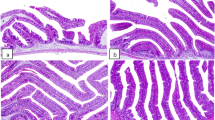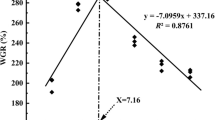Abstract
The aims of the study were (1) to determine the effect of rapeseed meal on growth, body composition, thyroid hormones, and expressions of three genes involved in thyroid function and (2) to determine if potassium iodide in the diet counteracts the adverse effect caused by rapeseed meal on growth. One fish meal-based diet was serviced as the control. The other six diets were designed on the basis of 3 × 2 factorial design. The rapeseed meal inclusion (10, 20, and 30%) and potassium iodide inclusion (0 and 72 mg (kg)−1) were set to be two factors. The fish experiment was designed according to a randomized block model with three size groups of fish (27.7, 19.9, and 8.1 g). The feeding period lasted for 71 days. The results showed that final weight, weight gain, specific growth rate (SGR), and feed conversion ratio (FCR) of fish fed with 10% rapeseed meal-based diets were significantly better than those fed with 20 and 30% rapeseed meal. The highest nitrogen retention and protein efficiency ratio (PER) were in the 10% rapeseed group. Inclusion of 30% rapeseed meal in the diets significantly reduced whole-fish dry matter, Ile, and Phe contents. The gene expressions of the thyrotropin receptor (TSHR), sodium/iodide symporter (NIS), and thyroid peroxidase (TPO), as well as the thyroid hormone (T3 and T4) levels in the plasma, were not affected by the different diets. However, TSHR and TPO gene expressions negatively correlated with T4 and lipid retention. NIS gene expression positively correlated with cumulative feed intake, final weight, weight gain, SGR, nitrogen retention, and PER. It also negatively correlated with FCR. In conclusion, the rapeseed meal inclusion level in the diet was suggested to be 10%. Potassium iodide in the diet (72 mg (kg)−1) did not counteract the adverse effects caused by rapeseed meal on fish growth. Correlations provided evidence to support the link between NIS gene and fish growth.


Similar content being viewed by others
Abbreviations
- DM:
-
Dry matter
- FCR:
-
Feed conversion ratio
- KI:
-
Potassium iodide
- NIS:
-
Sodium/iodide symporter
- PER:
-
Protein efficiency ratio
- SGR:
-
Specific growth rate
- T3 :
-
Triiodothyronine
- T4 :
-
Thyroxine
- TPO:
-
Thyroid peroxidase
- TSHR:
-
Thyrotropin receptor
References
Bell JM (1984) Nutrients and toxicants in rapeseed meal: a review. J Anim Sci 58:996–1010
Burel C, Boujard T, Escaffre AM, Kaushik SJ, Boeuf G, Mol KA, Van der Geyten S, Kuhn ER (2000a) Dietary low-glucosinolate rapeseed meal affects thyroid status and nutrient utilization in rainbow trout (Oncorhynchus mykiss). Br J Nutr 83:653–664
Burel C, Boujard T, Tulli F, Kaushik SJ (2000b) Digestibility of extruded peas, extruded lupin, and rapeseed meal in rainbow trout (Oncorhynchus mykiss) and turbot (Psetta maxima). Aquaculture 188:285–298
Burel C, Boujard T, Kaushik SJ, Boeuf G, Mol KA, Van der Geyten S, Darras VM, Kuhn ER, Pradet-Balade B, Querat B, Quinsac A, Krouti M, Ribaillier D (2001) Effects of rapeseed meal-glucosinolates on thyroid metabolism and feed utilization in rainbow trout. Gen Comp Endocrinol 124:343–358
Chen S, Andreasson E (2001) Update on glucosinolate metabolism and transport. Plant Physiol Biochem 39:743–758
Cheng Z, Ai Q, Mai K, Xu W, Ma H, Li Y, Zhang J (2010) Effects of dietary canola meal on growth performance, digestion and metabolism of Japanese seabass, Lateolabrax japonicus. Aquaculture 305:102–108
Davies SJ, McConnell S, Bateson RI (1990) Potential of rapeseed meal as an alternative protein source in complete diets for tilapia (Oreochromis mossambicus Peters). Aquaculture 87:145–154
De Martinis EC, Duvall RE, Hitchins AD (2007) Real-time PCR detection of 16S rRNA genes speeds most-probable-number enumeration of foodborne Listeria monocytogenes. J Food Prot 70:1650–1655
De Souza EC, Padron AS, Braga WM, de Andrade BM, Vaisman M, Nasciutti LE, Ferreira AC, de Carvalho DP (2010) MTOR downregulates iodide uptake in thyrocytes. J Endocrinol 206:113–120
Eales JG, Brown SB (2005) Thyroid. In: Mommsen TP, Moon TW (eds) Biochemistry and molecular biology of fishes, vol 6. Elsevier BV, Amsterdam, pp 397–412
EC (1998) Official Journal of European Communities, L257. European Communities, Luxembourg
Furuya VRB, Hayashi C, Furuya WM (1997) Canola meal as feeding for Nile tilapia (Oreochromis niloticus L.) during sexual reversion period. J Braz Soc Anim Sci 26:1067–1073
Gangadhara B, Nandeesha MC, Keshavanath P, Singh KP, Manissery JK (2002) Evaluation of rapeseed meal as a feed ingredient in catla (Catla catla) diets. J Aquac Trop 17:261–272
Garcia B, Santisteban P (2002) PI3K is involved in the IGF-I inhibition of TSH-induced sodium/iodide symporter gene expression. MolEndocrinol 16:342–352
Glencross B, Hawkins W, Curnow J (2004) Nutritional assessment of Australian canola meals. II. Evaluation of the influence of the canola oil extraction method on the protein value of canola meals fed to the red seabream (Pagrus auratus, Paulin). Aquac Res 35:25–34
Hawkyard M, Saele O, Nordgreen A, Langdon C, Hamre K (2011) Effect of iodine enrichment of Artemia sp. on their nutritional value for larval zebrafish (Danio rerio). Aquaculture 316:37–43
Higgs DA, Fagerlund UHM, McBride JR, Plotnikoff MD, Dosanjh BS, Markert JR, Davidson J (1983) Protein quality of Altex canola meal for juvenile chinook salmon (Oncorhynchus tshawytscha) considering dietary protein and 3,5,3′-triiodo-L-thyronine content. Aquaculture 34:213–238
Jiang J, Sh, D, Zhou XQ, Feng L, Liu Y, Jiang WD, Wu P, Tang L, Wang Y, Zhao Y (2015) Effects of lysine and methionine supplementation on growth, body composition and digestive function of grass carp (Ctenopharyngodon idella) fed plant protein diets using high-level canola meal. Aquac Nutr 22:1126–1133
Lim C, Klesius PH, Higgs DA (1998) Substitution of canola meal for soybean meal in diets for channel catfish Ictalurus punctatus. J World Aquac Soc 29:161–168
Luo Y, Ai Q, Mai K, Zhang W, Xu W, Zhang Y (2012) Effects of dietary rapeseed meal on growth performance, digestion and protein metabolism in relation to gene expression of juvenile cobia (Rachycentron canadum). Aquaculture 368:109–116
Ministry of Agriculturein China (2015) China fishery statistical yearbook. China Agriculture Press, Beijing
Mol KA, Van der Geyten S, Burel C, KuÈhn ER, Boujard T, Darras VM (1998) Comparative study of iodothyronine outer ring and inner ring deiodinase activities in five teleostean fishes. Fish Physiol Biochem 18:253–266
Mourente G, Bell JG (2006) Partial replacement of dietary fish oil with blends of vegetable oils (rapeseed, linseed and palm oils) in diets for European sea bass (Dicentrarchus labrax L.) over a long term growth study: effects on muscle and liver fatty acid composition and effectiveness of a fish oil finishing diet. Comp Biochem Physiol B Biochem Mol Biol 145:389–399
Nitschke U, Stengel DB (2015) A new HPLC method for the detection of iodine applied to natural samples of edible seaweeds and commercial seaweed food products. Food Chem 172:326–334
Novikov NP, Sokolovsky AS, Sokolovskaya TG, Yakovlev YM (2002) The fishes of Primorye. Far East State Technical Fishery University, Vladivostok
Nugon-Baudon L, Rabot S, Wal J-M, Szylit O (1990) Interactions of the intestinal microflora with glucosinolates in rapeseed meal toxicity: first evidence of an intestinal lactobacillus possessing a myrosinase-like activity in vivo. J Sci Food Agric 52:547–559
NRC (2011) Nutrient requirements of fish and shrimp. National Academy Press, Washington DC
Offical Journal of the European Union (2015) Concerning the authorisation of potassium iodide, calcium iodate anhydrous and coated granulated calcium iodate anhydrous as feed additives for all animal species. In: Commission TE (ed) Commission Implementing Regulation (EU) 2015/861 OF June 2015, p 7
Penglase S, Hamre K, Olsvik PA, Grotan E, Nordgreen A (2015) Rotifers enriched with iodine, copper and manganese had no effect on larval cod (Gadus morhua) growth, mineral status or redox system gene mRNA levels. Aquac Res 46:1793–1800
Ribeiro AR, Goncalves A, Colen R, Nunes ML, Dinis MT, Dias J (2015) Dietary macroalgae is a natural and effective tool to fortify gilthead seabream fillets with iodine: effects on growth, sensory quality and nutritional value. Aquaculture 437:51–59
Ribeiro ARA, Ribeiro L, Saele O, Dinis MT, Moren M (2012) Iodine and selenium supplementation increased survival and changed thyroid hormone status in Senegalese sole (Solea senegalensis) larvae reared in a recirculation system. Fish Physiol Biochem 38:725–734
Sarbassov DD, Ali SM, Sabatini DM (2005) Growing roles for the mTOR pathway. Curr Opin Cell Biol 17:596–603
SAS (1999) SAS/STAT user’s guide: version 8. SAS, Cary, NC
Satoh S, Higgs DA, Dosanjh BS, Hardy RW, Eales JG, Deacon G (1998) Effect of extrusion processing on the nutritive value of canola meal for chinook salmon (Oncorhynchus tshawytscha) in seawater. Aquac Nutr 4:115–122
Shafaeipour A, Yavari V, Falahatkar B, Maremmazi JG, Gorjipour E (2008) Effects of canola meal on physiological and biochemical parameters in rainbow trout (Oncorhynchus mykiss). Aquac Nutr 14:110–119
Simo R, Hernandez C, Saez-Lopez C, Soldevila B, Puig-Domingo M, Selva DM (2014) Thyroid hormone upregulates zinc-alpha2-glycoprotein production in the liver but not in adipose tissue. PLoS One 9:e85753
Sinha RA, You SH, Zhou J, Siddique MM, Bay BH, Zhu X, Privalsky ML, Cheng SY, Stevens RD, Summers SA, Newgard CB, Lazar MA, Yen PM (2012) Thyroid hormone stimulates hepatic lipid catabolism via activation of autophagy. J Clin Invest 122:2428–2438
Stephenson FH (2010) Calculations for molecular biology and biotechnology, a guide to mathematics in the laboratory, Second edn. Elsevier Inc, Amsterdam
Tan Q, Liu Q, Chen X, Wang M, Wu Z (2013) Growth performance, biochemical indices and hepatopancreatic function of grass carp, Ctenopharyngodon idellus, would be impaired by dietary rapeseed meal. Aquaculture 414:119–126
Tripathi MK, Mishra AS (2007) Glucosinolates in animal nutrition: a review. Anim Feed Sci Technol 132:1–27
USDA (2016) Oilseeds: world markets and trade. United States Department of Agriculture (USDA), Washington DC
Vaintraub IA, Lapteva NA (1988) Colorimetric determination of phytate in unpurified extracts of seeds and the products of their processing. Anal Biochem 175:227–230
Valente LMP, Rema P, Ferraro V, Pintado M, Sousa-Pinto I, Cunha LM, Oliveira MB, Araujo M (2015) Iodine enrichment of rainbow trout flesh by dietary supplementation with the red seaweed Gracilaria vermiculophylla. Aquaculture 446:132–139
Wallig MA, Belyea RL, Tumbleson ME (2002) Effect of pelleting on glucosinolate content of Crambe meal. Anim Feed Sci Technol 99:205–214
Wang C, Zhang H, Gao Y, Qian G (2016) Thyrotropin receptor cloning and expression response to dietary potassium iodide inclusion in yellow catfish (Pelteobagrus fulvidraco). Chin J Anim Nutr 29:940–952 (in Chinese)
Wang N (2009) A quantitative analysis method of glucosinolates in rapeseed meal. Science and Technology of Qinghai Agriculture and Forestry 3:58–59 (in Chinese)
Webster CD, Tiu LG, Tidwell JH, Grizzle JM (1997) Growth and body composition of channel catfish (Ictalurus punctatus) fed diets containing various percentages of canola meal. Aquaculture 150:103–112
Yao S, Zhu X, Chen K, Kan Y, Li C (2014) Analysis of yellow catfish (Tachysurus fulvidraco) culture model in Zhejiang region. China Fisheries 2:57–60 (In Chinese)
Acknowledgements
This work was supported by the Zhejiang Provincial Natural Science Foundation (grant number: LY14C190009), the Science and Technology Department of Zhejiang Province (grant number: 2017C32023), the Ningbo Natural Science Foundation (grant number: 2014A610193), and the Zhejiang Wanli University (grant number: ZS2012018).
Author information
Authors and Affiliations
Corresponding author
Rights and permissions
About this article
Cite this article
Wang, C., Jiang, L., Qian, G. et al. Supplying rapeseed meal to the diets with or without potassium iodide for yellow catfish (Tachysurus fulvidraco). Aquacult Int 25, 2061–2078 (2017). https://doi.org/10.1007/s10499-017-0171-9
Received:
Accepted:
Published:
Issue Date:
DOI: https://doi.org/10.1007/s10499-017-0171-9




